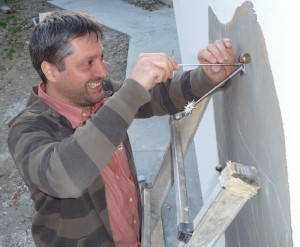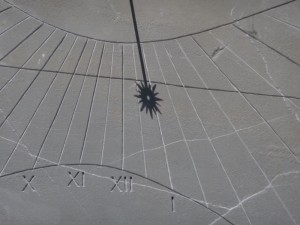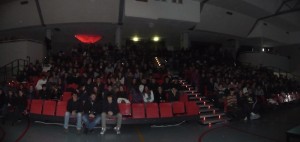The Stone Sundial finally sees the Sun

Ancient women in astronomy
March 28, 2010
The 42m E-ELT goes to Cerro Armazones – Chile!
April 26, 2010 You might remember last summer I had installed a stone sundial. Well, during the Easter vacations I finally found the time to complete it.
You might remember last summer I had installed a stone sundial. Well, during the Easter vacations I finally found the time to complete it.
After we had put it in place on the southerly wall of my friend’s house, I have asked my friend and ingenieur Armando to manufacture the gnomon. After a few weeks I gave him all the dimension and relevant specifications, he came back to me with a very nice piece of work. He had used stainless steel, and reproduced the sun at the end of the style with a laser cutting machine. The look of the piece is very high-tech, making a very nice contrast with the natural appearance of the stone and the ancient tradition of sun-dialing.
 The laser-cut sun has a small hole in the center, so that rather than by a pure shadow cast on the sundial tracks, the time is marked by a little bright spot, mimicking the sun.
The laser-cut sun has a small hole in the center, so that rather than by a pure shadow cast on the sundial tracks, the time is marked by a little bright spot, mimicking the sun.
After many months of silence, the stone sundial is now doing its job, discretely and without any need for maintenance.
Mane diu.
During the Easter vacations that was not the only astronomically oriented activity. In fact I have given two lectures to high school students. The first one was during their general assembly, when they use to invite an expert in a field of their choice. And this time it was the turn of astronomy. The auditorium was almost full, with about 450 people attending. A nice experience, indeed. The other seminar was much more specialistic and meant for the students of the last year. While in the general assembly I had presented the life of an astronomer (and more in general of a scientist), in this lecture I focused on the life in the universe, with special attention to ground based projects, like to ones carried out at ESO.
 Sometimes one fears it is impossible to surprise and bring enthusiasm to the young generation, since they have already seen everything. But this is actually not true. Maybe it is particularly easy with astronomy, I do not know, but they are very responsive and sensible to intellectual stimulation. Again, a nice experience.
Sometimes one fears it is impossible to surprise and bring enthusiasm to the young generation, since they have already seen everything. But this is actually not true. Maybe it is particularly easy with astronomy, I do not know, but they are very responsive and sensible to intellectual stimulation. Again, a nice experience.
Then, finally, I spent several hours during a nice spring night measuring the altitude of a number of bright stars with my good old Zeiss theodolite. You might wonder why. Well, the reason is two-fold. The first is a scientific one. I needed to test the accuracy I could achieve on the altitude measurements with that instrumental setup (it turns out to be of the order of 1 minute of arc) for my archaeoastronomical work. The second is more “educational”. I have always been told about atmospheric refraction and I wished to measure it directly, simply comparing the altitudes I got from my theodolite readings of objects at different zenith distances. As you might imagine, indeed, the atmospheric refraction is there and it clearly grows as one goes down to the horizon.
In all modern telescopes the refraction is taken into account automatically when you point. Even as a professional you do not even need to know it exists (as many other things, for that matter). However, from time to time I like to refresh my mind with this kind of experiments, which bring me back to the basic notions of classical astronomy (and make me feel a bit like Tycho 😉 ).

